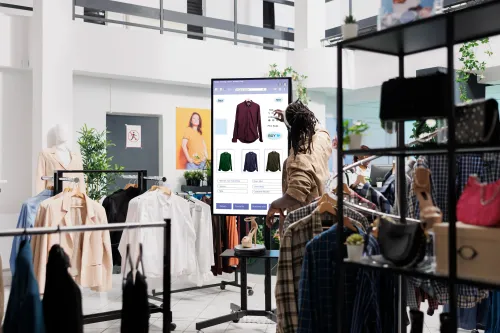

Real-Time Retail Personalization in the US: A Practical Guide






Today’s shoppers want more than just convenience; they expect personal and timely experiences. We’re surrounded by personalization every day: smartwatches remind us to move, and social apps serve content we enjoy. So, according to Epsilon and GBH Insights, it’s no surprise that 80% of U.S. adults want personalized shopping experiences.
While traditional systems gather and store customer data for later analysis, that delay can miss the moment of opportunity. Shoppers act in the moment, and to meet their expectations, brands must respond just as quickly. This is where stream processing plays a critical role.
Stream processing enables real-time personalization by analyzing data as it is created. It allows brands to deliver tailored content, product suggestions, or messages at the right time.
This blog explores how real-time personalization works, key system characteristics, how to build the right architecture, and common pitfalls to watch for.
Real-time personalization is about giving customers a tailored experience based on their actions. It uses live data such as browsing behavior, location, and current inventory to deliver relevant content, offers, and product suggestions instantly. The goal is to make every interaction feel timely and meaningful.
This kind of personalization may seem straightforward, but it relies on a fast and responsive system behind the scenes. As users interact with a website or app, their actions are captured, analyzed, and used to adjust what they see within milliseconds. This is only possible through real-time data processing.
Here are the key characteristics that make real-time personalization work:
Together, these characteristics create a responsive system that helps retailers engage customers in the right way and at the right time.
In the retail world, timing is everything. From showing the right product to the right person to restocking shelves before they’re empty, real-time decisions can make a huge difference. That’s where stream processing comes in.
Stream processing is a way to handle data as soon as it’s created. Instead of waiting to collect and analyze data later, it processes information in real time, helping retailers act immediately. Whether a shopper is browsing online or a point-of-sale system is updating inventory, stream processing allows this data to be used the moment it arrives.
To power real-time decisions, a stream processing setup typically includes:
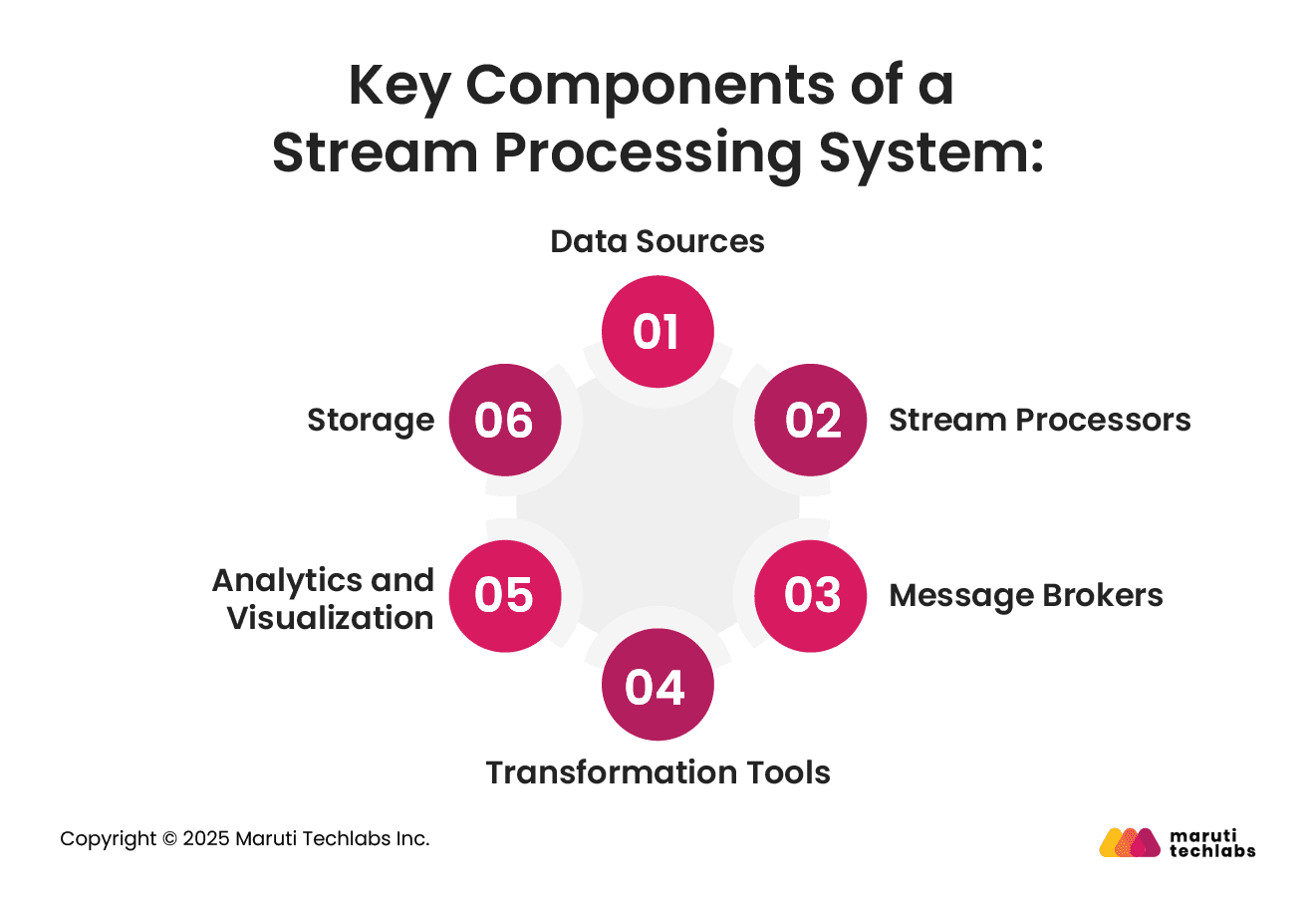
With the system in place, the next question is, what can retailers gain from real-time stream processing?
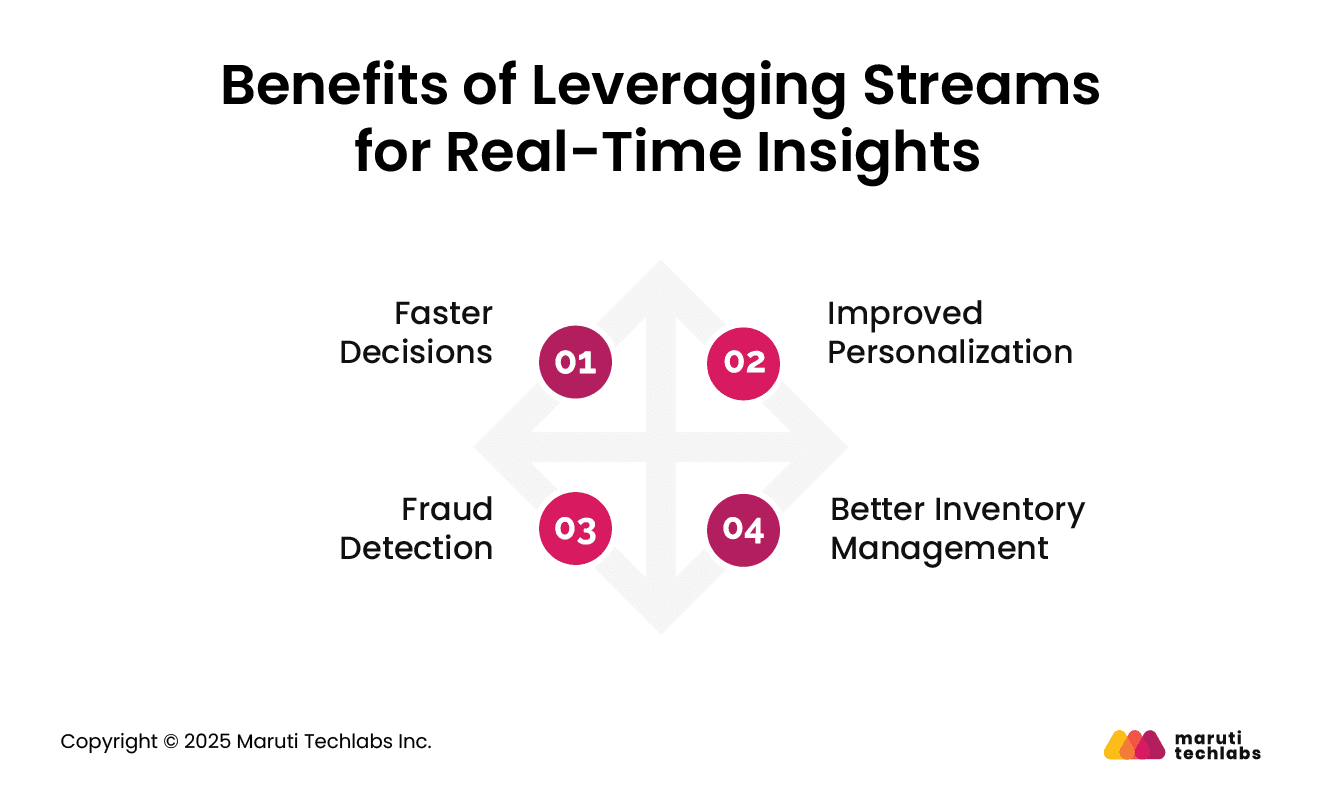
Knowing the benefits, here is how retailers can actually put stream processing into action:
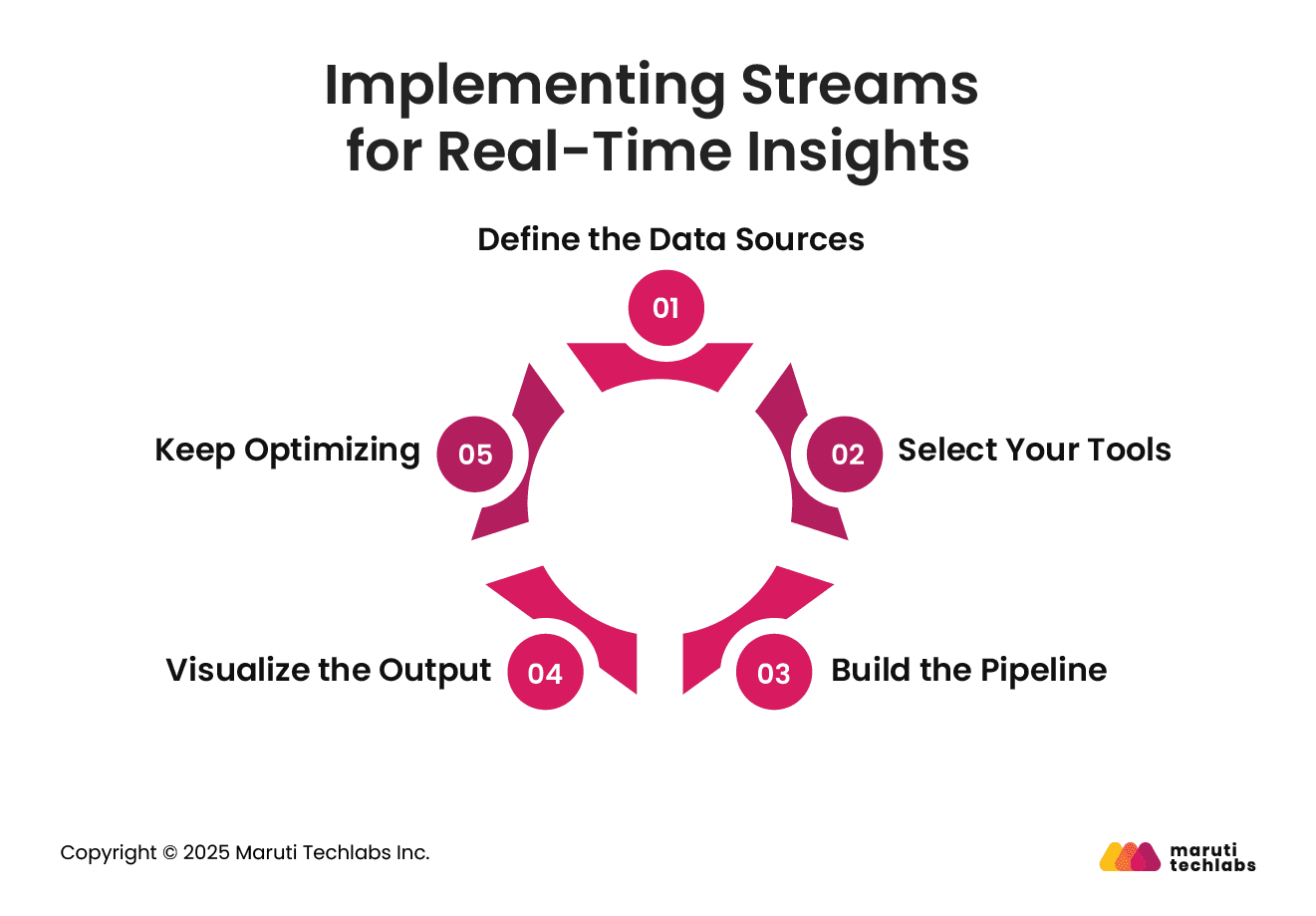
Retailers today need to make decisions as fast as their customers move, whether online, in-store, or across channels. Real-time data streaming architecture helps make this possible by continuously collecting, processing, and delivering data-driven insights. Here’s how a typical setup works:
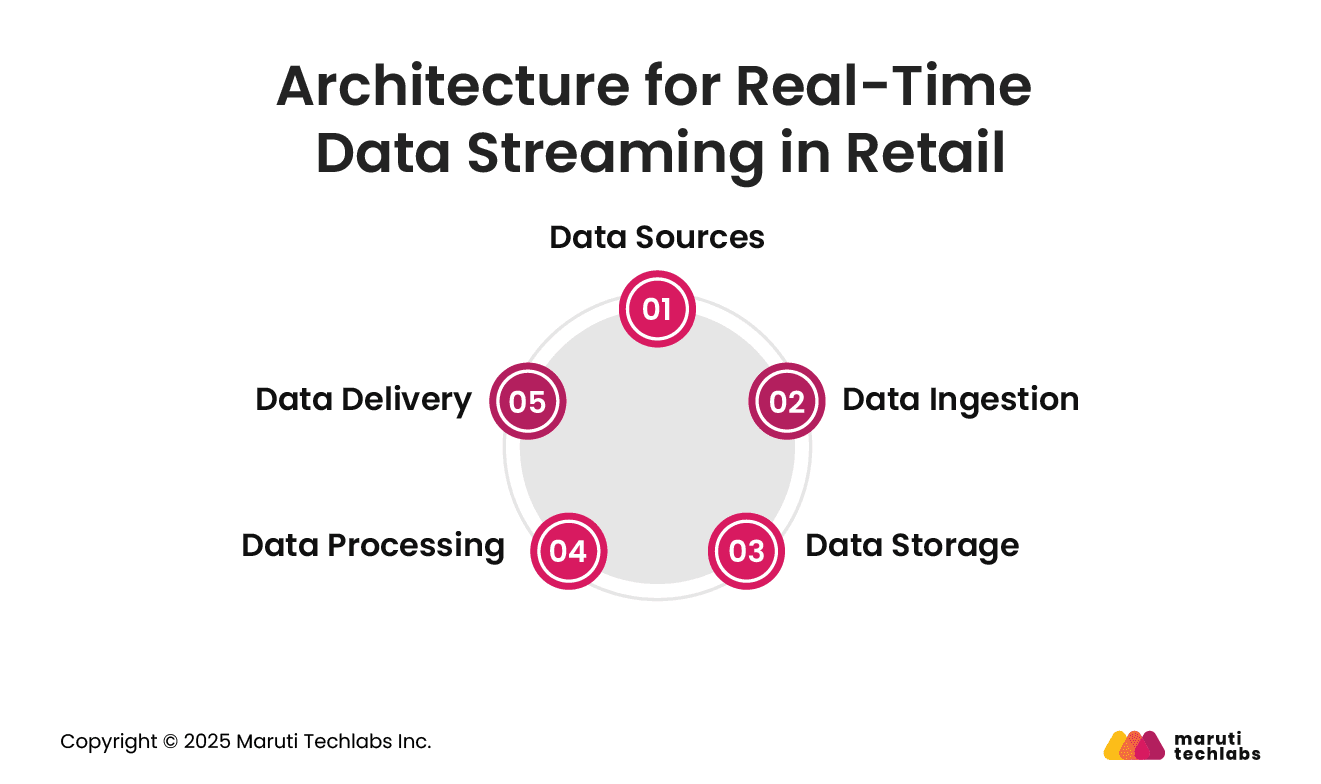
Retail businesses generate data from many places. These include:
All these systems act as the starting point of a real-time data pipeline.
Once the data is generated, it must be collected in real time. Tools like Apache NiFi and StreamSets help ingest data from different systems and send it to processing engines. They ensure data is properly formatted and filtered before moving further down the pipeline.
Retailers need storage that can handle huge volumes of incoming data without delays. Tools like Apache Kafka, Apache Pulsar, and NATS.IO act as the messaging backbone, temporarily holding the data while ensuring nothing gets lost and everything moves smoothly.
This is where insights are created. Frameworks like Apache Flink, Spark, or Beam help retailers spot real-time patterns, like sudden demand for a product, low stock alerts, or unusual customer behavior. These tools can process millions of data points in seconds to generate live insights.
Finally, the insights are sent to the people who need them. Delivery is key, whether it’s dashboards for store managers, inventory alerts for operations, or personalized offers shown to shoppers. This could be through APIs, mobile alerts, or business intelligence dashboards.
With the right architecture, retailers can act on data the moment it’s created, keeping them one step ahead.
In retail, real-time data streams can be handled in two main ways: stateless and stateful processing.
It processes each event independently, without retaining past context, making it fast, scalable, and ideal for handling self-contained data points.
Retail use cases for stateless processing:
On the other hand, stateful stream processing keeps track of past events. It builds context over time, making it ideal for tasks that require memory and historical insight.
Retail use cases for stateful processing:
Choosing between stateless and stateful depends on the complexity of your use case. Stateless works well for quick, one-off decisions, while stateful provides richer insights built on history.
While real-time personalization can transform customer experience, it’s easy to stumble if the streaming setup isn’t proper. Here are some common mistakes retail businesses should watch out for:
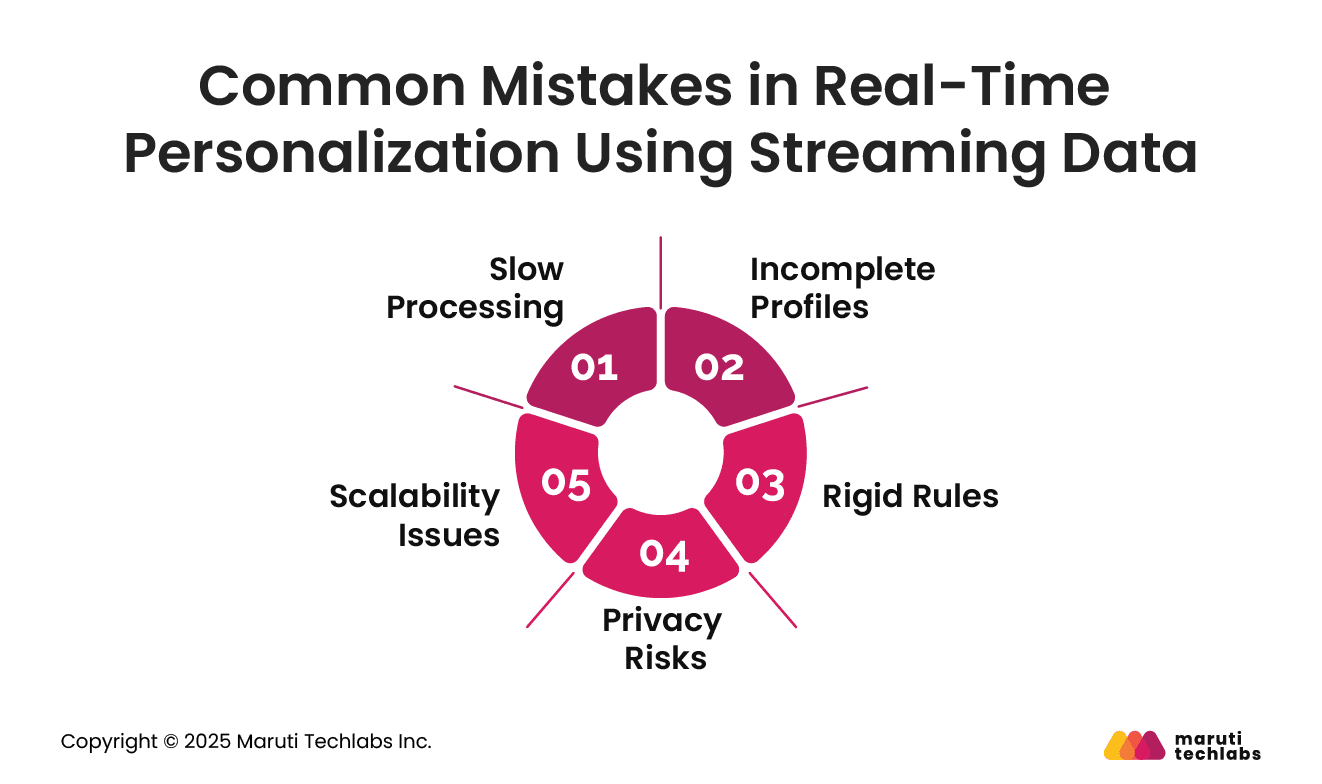
If your system takes too long to process data, recommendations can become outdated when they reach the customer. Use low-latency pipelines to keep up with fast-changing behavior.
Relying on limited data sources leads to shallow personalization. Make sure to stream data from all touchpoints—mobile apps, websites, in-store kiosks, and loyalty programs, for a full customer picture.
Predefined personalization rules cannot adapt quickly to new trends or customer behavior shifts. To keep recommendations relevant, combine streaming with real-time machine learning models.
Streaming data in real-time increases the risk of compliance breaches. Consistently enforce user consent and anonymize personal information to stay within privacy laws like GDPR and CCPA.
Traffic surges like holiday sales can overwhelm systems. Build an auto-scaling architecture that can grow with your data volume and customer base without breaking under pressure.
Avoiding these pitfalls helps ensure your real-time personalization is not just fast but also smart, secure, and future-ready.
Real-time data streaming is no longer optional for retailers. Shoppers today expect fast, personalized, and connected experiences across every channel, and delayed data just doesn’t cut it anymore.
Retail media is evolving beyond simply placing ads on a website. It’s now about delivering timely, data-driven interactions wherever the customer is—online, in-store, or through mobile apps. With platforms like Kafka and Flink, retailers can unify all touchpoints, personalize experiences using AI, and optimize campaigns while they’re still running.
Unique Vogue leveraged real-time streaming and agile development to launch a luxury online shopping platform. Understanding the need for speed and efficiency, Maruti Techlabs partnered with them to build a fully functional MVP in six weeks. By cutting development time by 60% and using just 40% of the engineering budget, we helped Unique Vogue launch faster and focus on user acquisition. Check out the full case study here.
As customer expectations grow, building the right real-time architecture is key. At Maruti Techlabs, our Data Engineering services help retailers build systems that scale, personalize, and deliver insights as they happen. Contact us for real-time capabilities and to stay competitive in today’s retail world.
A stateful firewall remembers the state of past traffic and uses it to make smarter decisions about new connections. It tracks ongoing sessions and knows if a packet is part of a valid conversation. A stateless firewall, on the other hand, checks each packet on its own without context, making it faster but less aware of traffic behavior or potential threats.
Personalization of real-time data streams is typically achieved using machine learning models and event-driven architectures. These systems track user behavior across devices and respond instantly with tailored content, offers, or ads.
Technologies like Kafka and Flink help process this data quickly so recommendations can be updated on the fly, based on the user’s most recent actions and preferences.
The main difference is memory. A stateful system remembers previous data or interactions, which helps it make more thoughtful decisions over time. A stateless system treats each event separately, without remembering what happened before. Stateful systems are better for fraud detection or session tracking, while stateless systems are simpler and faster for tasks like filtering or logging.
Data streaming architecture is the setup that lets companies process data in real time as it’s generated. It includes sources like websites, apps, or sensors; tools to collect the data (like Kafka); processing engines (like Flink); and systems to store or deliver insights.
This architecture helps businesses react instantly, personalizing experiences, flagging issues, or triggering automated actions as events happen.


